MARKETING CONSUMER BEHAVIOR.
VerifiedAdded on 2023/03/31
|17
|4146
|196
AI Summary
Students are required to choose a single brand within a product category, and find and collect that brand-related information (e.g. advertisements, news/business articles, websites). After careful analysis of the brand’s current marketing, students must then describe the areas in which the use of two (maximum three) consumer behaviour theories or concepts have been applied to market the chosen brand by the firm/organisation. The key is to identify how the firm marketing the chosen brand are attempting to influence, modify or impact the consumers’ decision-making and behaviour using specific consumer behaviour theory. Students must reinforce their discussion with clear evidence (i.e. scholarly articles) that support, explain and critique consumer behaviour theory within the brand information that they have collected. It is strongly recommended that students attend lecture and workshop sessions to share and exchange ideas on the development of the report. Please follow the assignment br
Contribute Materials
Your contribution can guide someone’s learning journey. Share your
documents today.
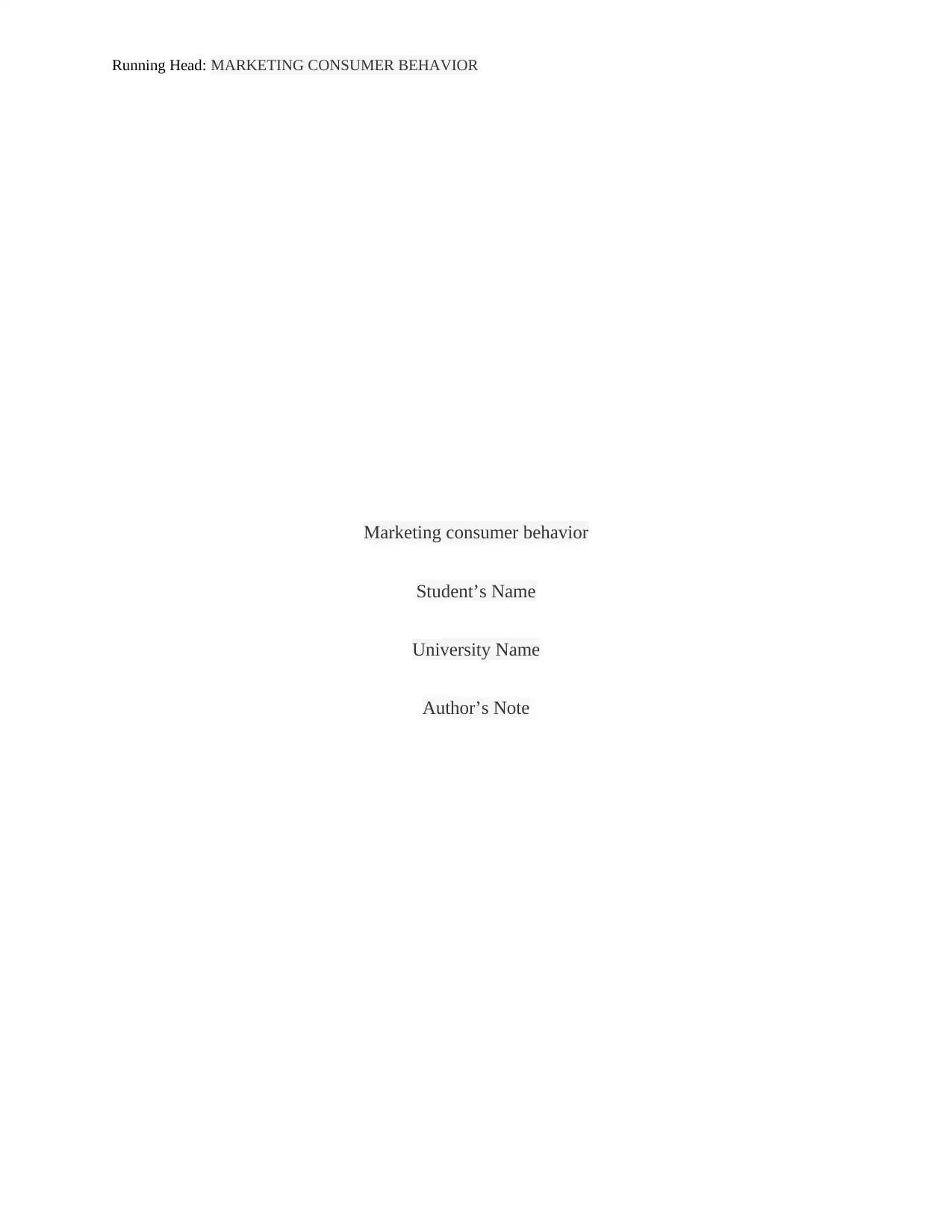
Running Head: MARKETING CONSUMER BEHAVIOR
Marketing consumer behavior
Student’s Name
University Name
Author’s Note
Marketing consumer behavior
Student’s Name
University Name
Author’s Note
Secure Best Marks with AI Grader
Need help grading? Try our AI Grader for instant feedback on your assignments.
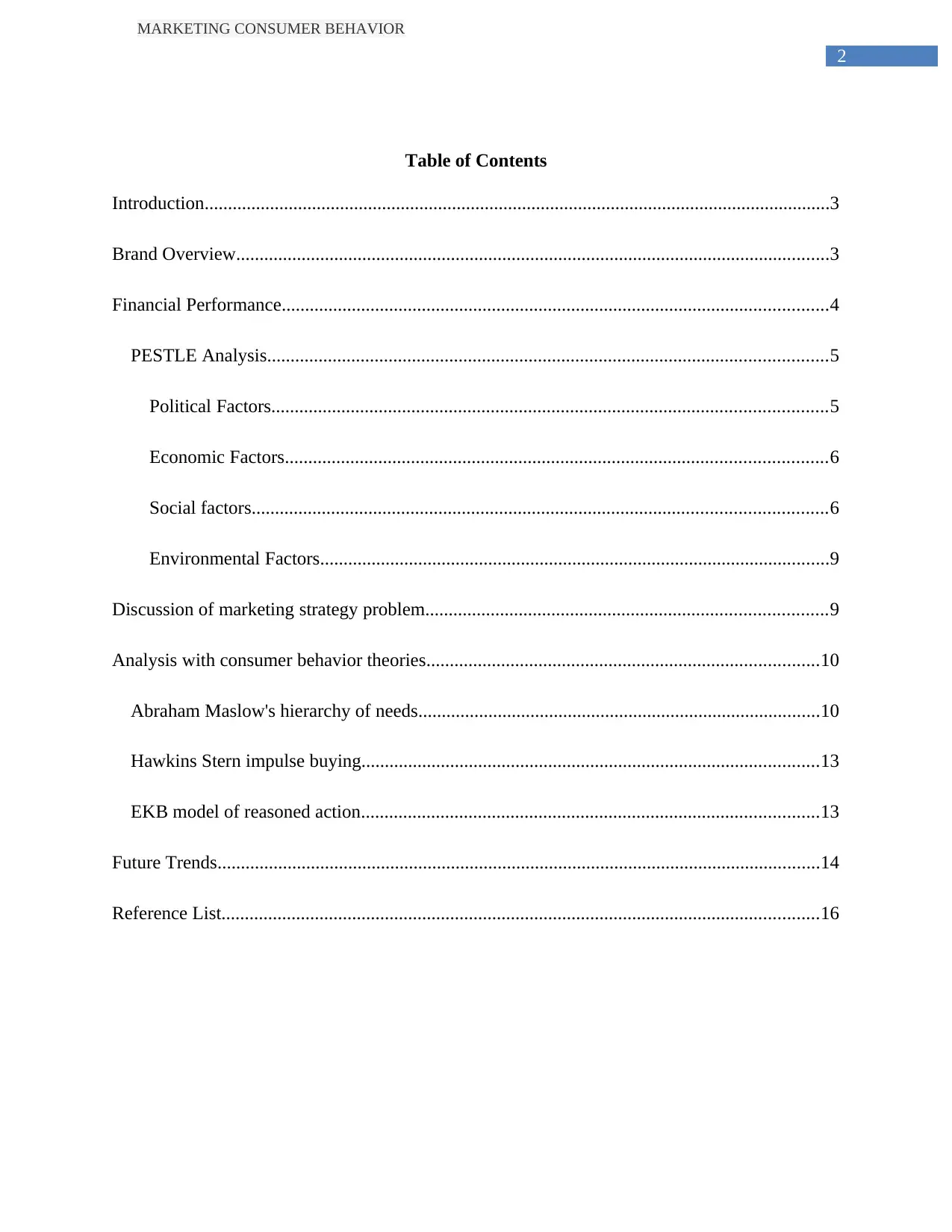
2
MARKETING CONSUMER BEHAVIOR
Table of Contents
Introduction......................................................................................................................................3
Brand Overview...............................................................................................................................3
Financial Performance.....................................................................................................................4
PESTLE Analysis........................................................................................................................5
Political Factors.......................................................................................................................5
Economic Factors....................................................................................................................6
Social factors...........................................................................................................................6
Environmental Factors.............................................................................................................9
Discussion of marketing strategy problem......................................................................................9
Analysis with consumer behavior theories....................................................................................10
Abraham Maslow's hierarchy of needs......................................................................................10
Hawkins Stern impulse buying..................................................................................................13
EKB model of reasoned action..................................................................................................13
Future Trends.................................................................................................................................14
Reference List................................................................................................................................16
MARKETING CONSUMER BEHAVIOR
Table of Contents
Introduction......................................................................................................................................3
Brand Overview...............................................................................................................................3
Financial Performance.....................................................................................................................4
PESTLE Analysis........................................................................................................................5
Political Factors.......................................................................................................................5
Economic Factors....................................................................................................................6
Social factors...........................................................................................................................6
Environmental Factors.............................................................................................................9
Discussion of marketing strategy problem......................................................................................9
Analysis with consumer behavior theories....................................................................................10
Abraham Maslow's hierarchy of needs......................................................................................10
Hawkins Stern impulse buying..................................................................................................13
EKB model of reasoned action..................................................................................................13
Future Trends.................................................................................................................................14
Reference List................................................................................................................................16
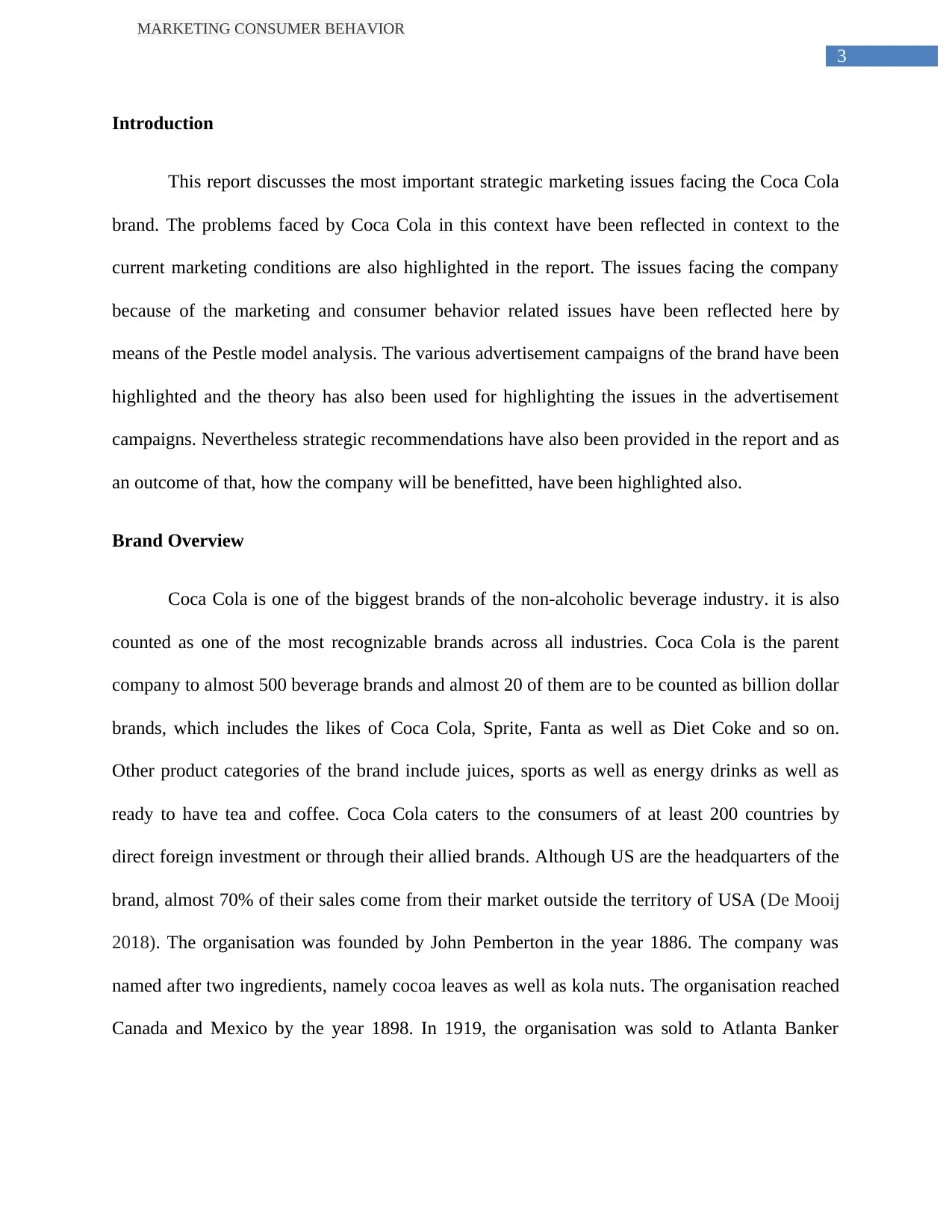
3
MARKETING CONSUMER BEHAVIOR
Introduction
This report discusses the most important strategic marketing issues facing the Coca Cola
brand. The problems faced by Coca Cola in this context have been reflected in context to the
current marketing conditions are also highlighted in the report. The issues facing the company
because of the marketing and consumer behavior related issues have been reflected here by
means of the Pestle model analysis. The various advertisement campaigns of the brand have been
highlighted and the theory has also been used for highlighting the issues in the advertisement
campaigns. Nevertheless strategic recommendations have also been provided in the report and as
an outcome of that, how the company will be benefitted, have been highlighted also.
Brand Overview
Coca Cola is one of the biggest brands of the non-alcoholic beverage industry. it is also
counted as one of the most recognizable brands across all industries. Coca Cola is the parent
company to almost 500 beverage brands and almost 20 of them are to be counted as billion dollar
brands, which includes the likes of Coca Cola, Sprite, Fanta as well as Diet Coke and so on.
Other product categories of the brand include juices, sports as well as energy drinks as well as
ready to have tea and coffee. Coca Cola caters to the consumers of at least 200 countries by
direct foreign investment or through their allied brands. Although US are the headquarters of the
brand, almost 70% of their sales come from their market outside the territory of USA (De Mooij
2018). The organisation was founded by John Pemberton in the year 1886. The company was
named after two ingredients, namely cocoa leaves as well as kola nuts. The organisation reached
Canada and Mexico by the year 1898. In 1919, the organisation was sold to Atlanta Banker
MARKETING CONSUMER BEHAVIOR
Introduction
This report discusses the most important strategic marketing issues facing the Coca Cola
brand. The problems faced by Coca Cola in this context have been reflected in context to the
current marketing conditions are also highlighted in the report. The issues facing the company
because of the marketing and consumer behavior related issues have been reflected here by
means of the Pestle model analysis. The various advertisement campaigns of the brand have been
highlighted and the theory has also been used for highlighting the issues in the advertisement
campaigns. Nevertheless strategic recommendations have also been provided in the report and as
an outcome of that, how the company will be benefitted, have been highlighted also.
Brand Overview
Coca Cola is one of the biggest brands of the non-alcoholic beverage industry. it is also
counted as one of the most recognizable brands across all industries. Coca Cola is the parent
company to almost 500 beverage brands and almost 20 of them are to be counted as billion dollar
brands, which includes the likes of Coca Cola, Sprite, Fanta as well as Diet Coke and so on.
Other product categories of the brand include juices, sports as well as energy drinks as well as
ready to have tea and coffee. Coca Cola caters to the consumers of at least 200 countries by
direct foreign investment or through their allied brands. Although US are the headquarters of the
brand, almost 70% of their sales come from their market outside the territory of USA (De Mooij
2018). The organisation was founded by John Pemberton in the year 1886. The company was
named after two ingredients, namely cocoa leaves as well as kola nuts. The organisation reached
Canada and Mexico by the year 1898. In 1919, the organisation was sold to Atlanta Banker
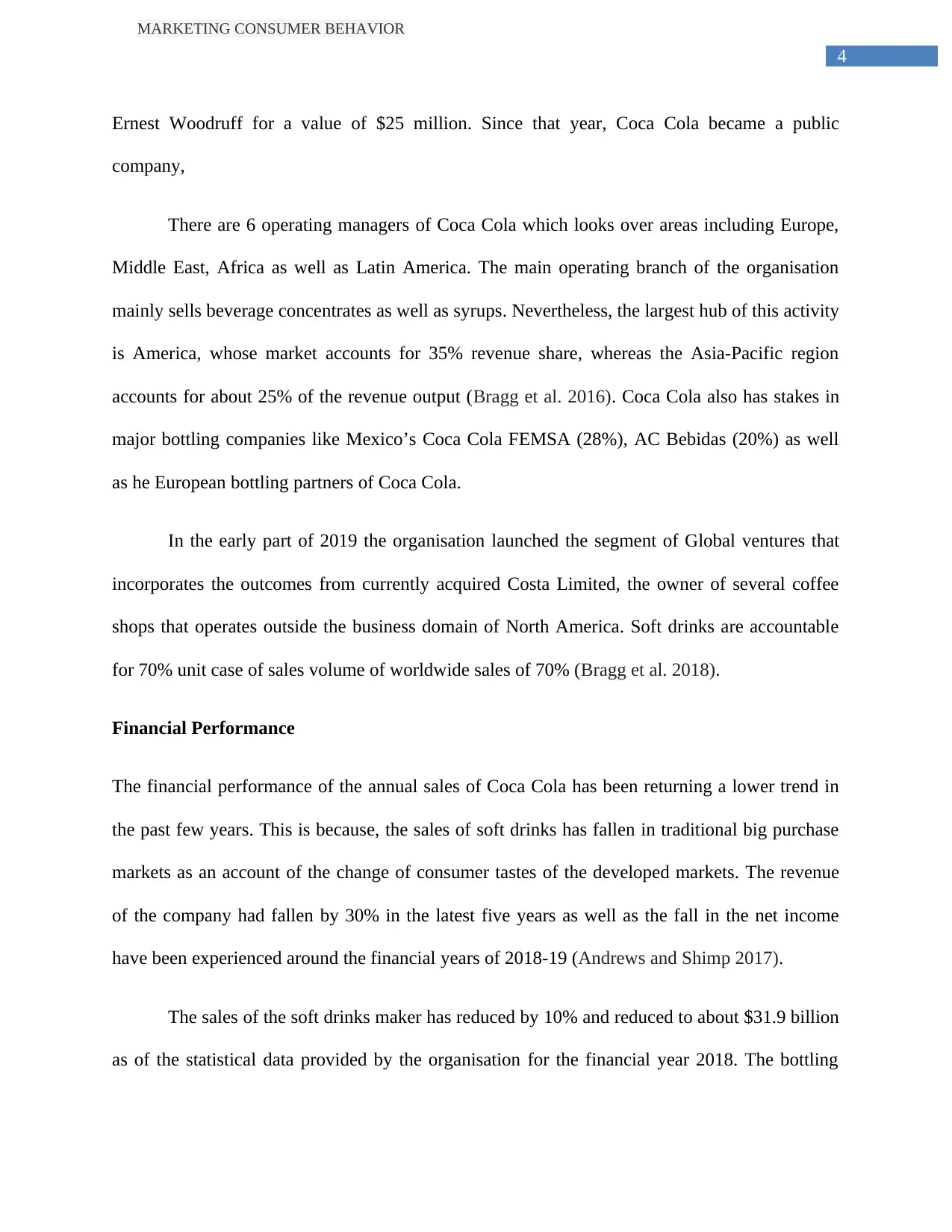
4
MARKETING CONSUMER BEHAVIOR
Ernest Woodruff for a value of $25 million. Since that year, Coca Cola became a public
company,
There are 6 operating managers of Coca Cola which looks over areas including Europe,
Middle East, Africa as well as Latin America. The main operating branch of the organisation
mainly sells beverage concentrates as well as syrups. Nevertheless, the largest hub of this activity
is America, whose market accounts for 35% revenue share, whereas the Asia-Pacific region
accounts for about 25% of the revenue output (Bragg et al. 2016). Coca Cola also has stakes in
major bottling companies like Mexico’s Coca Cola FEMSA (28%), AC Bebidas (20%) as well
as he European bottling partners of Coca Cola.
In the early part of 2019 the organisation launched the segment of Global ventures that
incorporates the outcomes from currently acquired Costa Limited, the owner of several coffee
shops that operates outside the business domain of North America. Soft drinks are accountable
for 70% unit case of sales volume of worldwide sales of 70% (Bragg et al. 2018).
Financial Performance
The financial performance of the annual sales of Coca Cola has been returning a lower trend in
the past few years. This is because, the sales of soft drinks has fallen in traditional big purchase
markets as an account of the change of consumer tastes of the developed markets. The revenue
of the company had fallen by 30% in the latest five years as well as the fall in the net income
have been experienced around the financial years of 2018-19 (Andrews and Shimp 2017).
The sales of the soft drinks maker has reduced by 10% and reduced to about $31.9 billion
as of the statistical data provided by the organisation for the financial year 2018. The bottling
MARKETING CONSUMER BEHAVIOR
Ernest Woodruff for a value of $25 million. Since that year, Coca Cola became a public
company,
There are 6 operating managers of Coca Cola which looks over areas including Europe,
Middle East, Africa as well as Latin America. The main operating branch of the organisation
mainly sells beverage concentrates as well as syrups. Nevertheless, the largest hub of this activity
is America, whose market accounts for 35% revenue share, whereas the Asia-Pacific region
accounts for about 25% of the revenue output (Bragg et al. 2016). Coca Cola also has stakes in
major bottling companies like Mexico’s Coca Cola FEMSA (28%), AC Bebidas (20%) as well
as he European bottling partners of Coca Cola.
In the early part of 2019 the organisation launched the segment of Global ventures that
incorporates the outcomes from currently acquired Costa Limited, the owner of several coffee
shops that operates outside the business domain of North America. Soft drinks are accountable
for 70% unit case of sales volume of worldwide sales of 70% (Bragg et al. 2018).
Financial Performance
The financial performance of the annual sales of Coca Cola has been returning a lower trend in
the past few years. This is because, the sales of soft drinks has fallen in traditional big purchase
markets as an account of the change of consumer tastes of the developed markets. The revenue
of the company had fallen by 30% in the latest five years as well as the fall in the net income
have been experienced around the financial years of 2018-19 (Andrews and Shimp 2017).
The sales of the soft drinks maker has reduced by 10% and reduced to about $31.9 billion
as of the statistical data provided by the organisation for the financial year 2018. The bottling
Secure Best Marks with AI Grader
Need help grading? Try our AI Grader for instant feedback on your assignments.
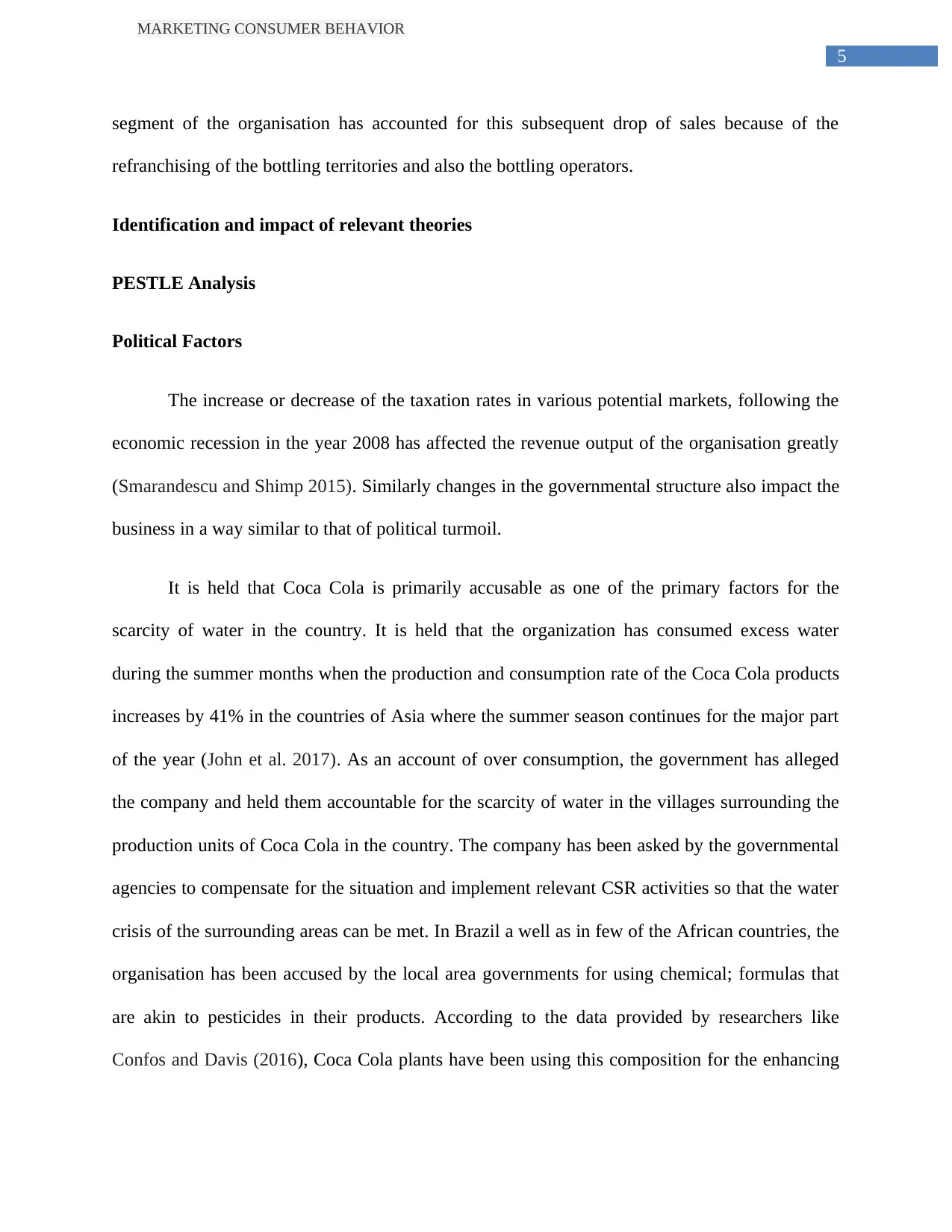
5
MARKETING CONSUMER BEHAVIOR
segment of the organisation has accounted for this subsequent drop of sales because of the
refranchising of the bottling territories and also the bottling operators.
Identification and impact of relevant theories
PESTLE Analysis
Political Factors
The increase or decrease of the taxation rates in various potential markets, following the
economic recession in the year 2008 has affected the revenue output of the organisation greatly
(Smarandescu and Shimp 2015). Similarly changes in the governmental structure also impact the
business in a way similar to that of political turmoil.
It is held that Coca Cola is primarily accusable as one of the primary factors for the
scarcity of water in the country. It is held that the organization has consumed excess water
during the summer months when the production and consumption rate of the Coca Cola products
increases by 41% in the countries of Asia where the summer season continues for the major part
of the year (John et al. 2017). As an account of over consumption, the government has alleged
the company and held them accountable for the scarcity of water in the villages surrounding the
production units of Coca Cola in the country. The company has been asked by the governmental
agencies to compensate for the situation and implement relevant CSR activities so that the water
crisis of the surrounding areas can be met. In Brazil a well as in few of the African countries, the
organisation has been accused by the local area governments for using chemical; formulas that
are akin to pesticides in their products. According to the data provided by researchers like
Confos and Davis (2016), Coca Cola plants have been using this composition for the enhancing
MARKETING CONSUMER BEHAVIOR
segment of the organisation has accounted for this subsequent drop of sales because of the
refranchising of the bottling territories and also the bottling operators.
Identification and impact of relevant theories
PESTLE Analysis
Political Factors
The increase or decrease of the taxation rates in various potential markets, following the
economic recession in the year 2008 has affected the revenue output of the organisation greatly
(Smarandescu and Shimp 2015). Similarly changes in the governmental structure also impact the
business in a way similar to that of political turmoil.
It is held that Coca Cola is primarily accusable as one of the primary factors for the
scarcity of water in the country. It is held that the organization has consumed excess water
during the summer months when the production and consumption rate of the Coca Cola products
increases by 41% in the countries of Asia where the summer season continues for the major part
of the year (John et al. 2017). As an account of over consumption, the government has alleged
the company and held them accountable for the scarcity of water in the villages surrounding the
production units of Coca Cola in the country. The company has been asked by the governmental
agencies to compensate for the situation and implement relevant CSR activities so that the water
crisis of the surrounding areas can be met. In Brazil a well as in few of the African countries, the
organisation has been accused by the local area governments for using chemical; formulas that
are akin to pesticides in their products. According to the data provided by researchers like
Confos and Davis (2016), Coca Cola plants have been using this composition for the enhancing

6
MARKETING CONSUMER BEHAVIOR
the taste and carbonation proportion. The business activities as well as the revenue generation of
the company had been hampered as an outcome of theses political tussles.
Economic Factors
The global crisis that occurred recently, have been the reason for the reduction of the profit
returns of Coca Cola recently. However, the impact of this financial down turn have been mainly
experienced by the financing companies of Coca Cola and the main company was able to stay
afloat among the crisis, however accounting for the loss of profits to some extent.
The economic crisis that hit many countries of the world alike, have been accountable for
the loss of purchasing parity of majority of the section of the consumer base of the .organisation.
Under the condition of lean purchasing power the most loyal base of customers exhibited the
trend of purchasing only the basic necessities in order to execute the impact of the financial
crisis.
Again, it is evident that the transportation and logistics cost of the company have also
enhanced because of the improvised laws of the various local as well as national governments
that claimed that international businesses with carbon output value of over 0.33 will be
chargeable and on case of exceeding the value by 0.50, the organization have to undergo
penalizations and also develop measures for the reduction of the carbon emission volume
(Boelsen-Robinson, Backholer and Peeters 2015).
Social factors
One of the social challenges that have become a factor of concern for Coca Cola is that many of
the customers have shifted from the consumption trend of aerated and carbonated drinks to that
MARKETING CONSUMER BEHAVIOR
the taste and carbonation proportion. The business activities as well as the revenue generation of
the company had been hampered as an outcome of theses political tussles.
Economic Factors
The global crisis that occurred recently, have been the reason for the reduction of the profit
returns of Coca Cola recently. However, the impact of this financial down turn have been mainly
experienced by the financing companies of Coca Cola and the main company was able to stay
afloat among the crisis, however accounting for the loss of profits to some extent.
The economic crisis that hit many countries of the world alike, have been accountable for
the loss of purchasing parity of majority of the section of the consumer base of the .organisation.
Under the condition of lean purchasing power the most loyal base of customers exhibited the
trend of purchasing only the basic necessities in order to execute the impact of the financial
crisis.
Again, it is evident that the transportation and logistics cost of the company have also
enhanced because of the improvised laws of the various local as well as national governments
that claimed that international businesses with carbon output value of over 0.33 will be
chargeable and on case of exceeding the value by 0.50, the organization have to undergo
penalizations and also develop measures for the reduction of the carbon emission volume
(Boelsen-Robinson, Backholer and Peeters 2015).
Social factors
One of the social challenges that have become a factor of concern for Coca Cola is that many of
the customers have shifted from the consumption trend of aerated and carbonated drinks to that

7
MARKETING CONSUMER BEHAVIOR
of the healthy drinks. It is evident that this change of the market trend is going to affect the sales
of top 20 categories of products that are sold by the biggest subsidiaries of Coca Cola brand. The
products sold under the Coca Cola brand name are mainly popular because of the flavors induced
in them (Dholakia 2016). However, the growing concerns regarding the usage of the harmful
chemicals in the Coca Cola products and release of constant videos by various popular food
bloggers making the people cautious about the sugar content of the product have accounted for a
sharp drop of sales in the selective markets.
The Drop in revenue of Coca Cola showing the drop of unit sales
(Source: Cocacola.com, 2019)
However with the growth in awareness among the people regarding the harmful impacts of
carbonated and artificially flavored drinks, the organisation is making greater investments over
the marketing campaigns, thereby promoting the value propositions like the family time and
mass happiness which can be provided by Coca Cola, by exhibiting the propensity of the people
MARKETING CONSUMER BEHAVIOR
of the healthy drinks. It is evident that this change of the market trend is going to affect the sales
of top 20 categories of products that are sold by the biggest subsidiaries of Coca Cola brand. The
products sold under the Coca Cola brand name are mainly popular because of the flavors induced
in them (Dholakia 2016). However, the growing concerns regarding the usage of the harmful
chemicals in the Coca Cola products and release of constant videos by various popular food
bloggers making the people cautious about the sugar content of the product have accounted for a
sharp drop of sales in the selective markets.
The Drop in revenue of Coca Cola showing the drop of unit sales
(Source: Cocacola.com, 2019)
However with the growth in awareness among the people regarding the harmful impacts of
carbonated and artificially flavored drinks, the organisation is making greater investments over
the marketing campaigns, thereby promoting the value propositions like the family time and
mass happiness which can be provided by Coca Cola, by exhibiting the propensity of the people
Paraphrase This Document
Need a fresh take? Get an instant paraphrase of this document with our AI Paraphraser
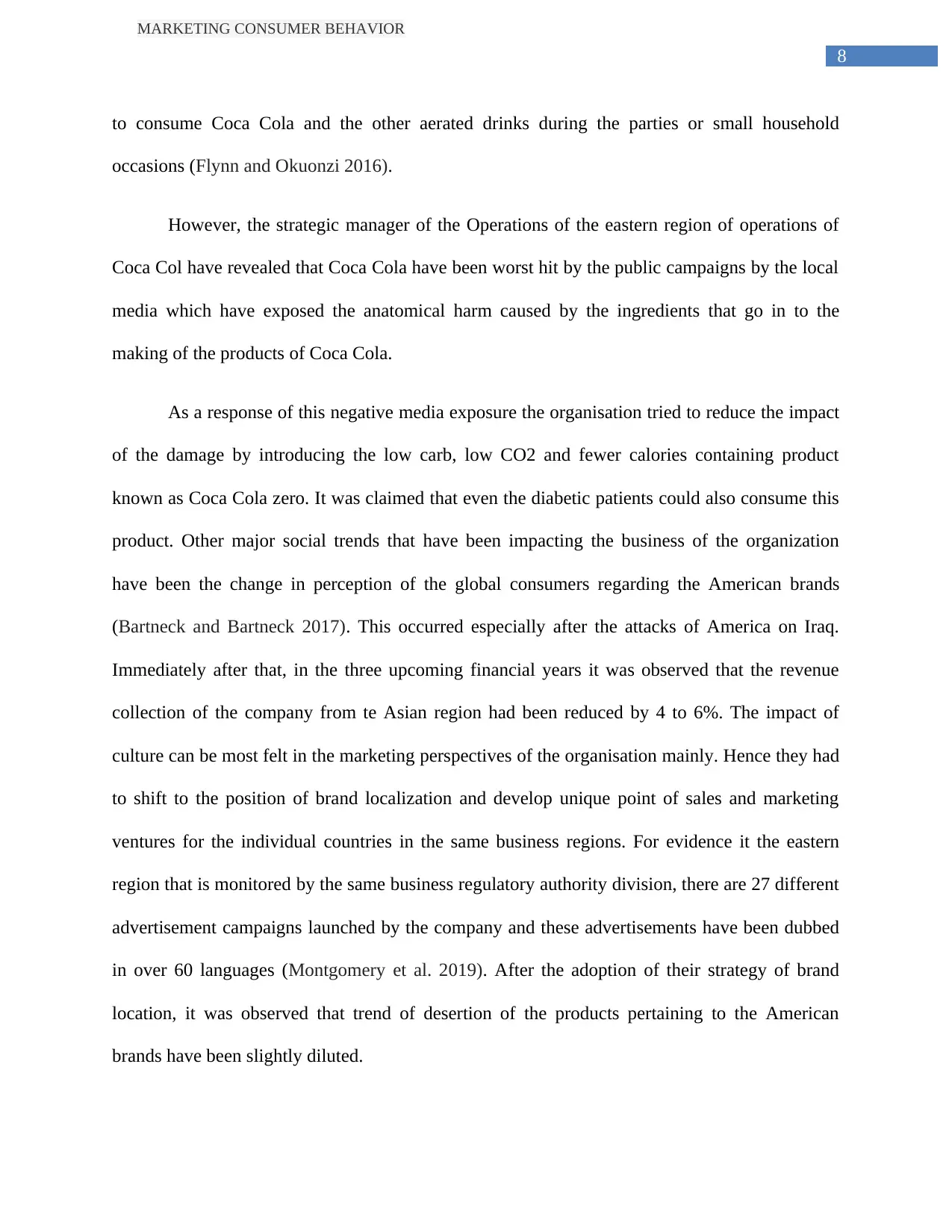
8
MARKETING CONSUMER BEHAVIOR
to consume Coca Cola and the other aerated drinks during the parties or small household
occasions (Flynn and Okuonzi 2016).
However, the strategic manager of the Operations of the eastern region of operations of
Coca Col have revealed that Coca Cola have been worst hit by the public campaigns by the local
media which have exposed the anatomical harm caused by the ingredients that go in to the
making of the products of Coca Cola.
As a response of this negative media exposure the organisation tried to reduce the impact
of the damage by introducing the low carb, low CO2 and fewer calories containing product
known as Coca Cola zero. It was claimed that even the diabetic patients could also consume this
product. Other major social trends that have been impacting the business of the organization
have been the change in perception of the global consumers regarding the American brands
(Bartneck and Bartneck 2017). This occurred especially after the attacks of America on Iraq.
Immediately after that, in the three upcoming financial years it was observed that the revenue
collection of the company from te Asian region had been reduced by 4 to 6%. The impact of
culture can be most felt in the marketing perspectives of the organisation mainly. Hence they had
to shift to the position of brand localization and develop unique point of sales and marketing
ventures for the individual countries in the same business regions. For evidence it the eastern
region that is monitored by the same business regulatory authority division, there are 27 different
advertisement campaigns launched by the company and these advertisements have been dubbed
in over 60 languages (Montgomery et al. 2019). After the adoption of their strategy of brand
location, it was observed that trend of desertion of the products pertaining to the American
brands have been slightly diluted.
MARKETING CONSUMER BEHAVIOR
to consume Coca Cola and the other aerated drinks during the parties or small household
occasions (Flynn and Okuonzi 2016).
However, the strategic manager of the Operations of the eastern region of operations of
Coca Col have revealed that Coca Cola have been worst hit by the public campaigns by the local
media which have exposed the anatomical harm caused by the ingredients that go in to the
making of the products of Coca Cola.
As a response of this negative media exposure the organisation tried to reduce the impact
of the damage by introducing the low carb, low CO2 and fewer calories containing product
known as Coca Cola zero. It was claimed that even the diabetic patients could also consume this
product. Other major social trends that have been impacting the business of the organization
have been the change in perception of the global consumers regarding the American brands
(Bartneck and Bartneck 2017). This occurred especially after the attacks of America on Iraq.
Immediately after that, in the three upcoming financial years it was observed that the revenue
collection of the company from te Asian region had been reduced by 4 to 6%. The impact of
culture can be most felt in the marketing perspectives of the organisation mainly. Hence they had
to shift to the position of brand localization and develop unique point of sales and marketing
ventures for the individual countries in the same business regions. For evidence it the eastern
region that is monitored by the same business regulatory authority division, there are 27 different
advertisement campaigns launched by the company and these advertisements have been dubbed
in over 60 languages (Montgomery et al. 2019). After the adoption of their strategy of brand
location, it was observed that trend of desertion of the products pertaining to the American
brands have been slightly diluted.
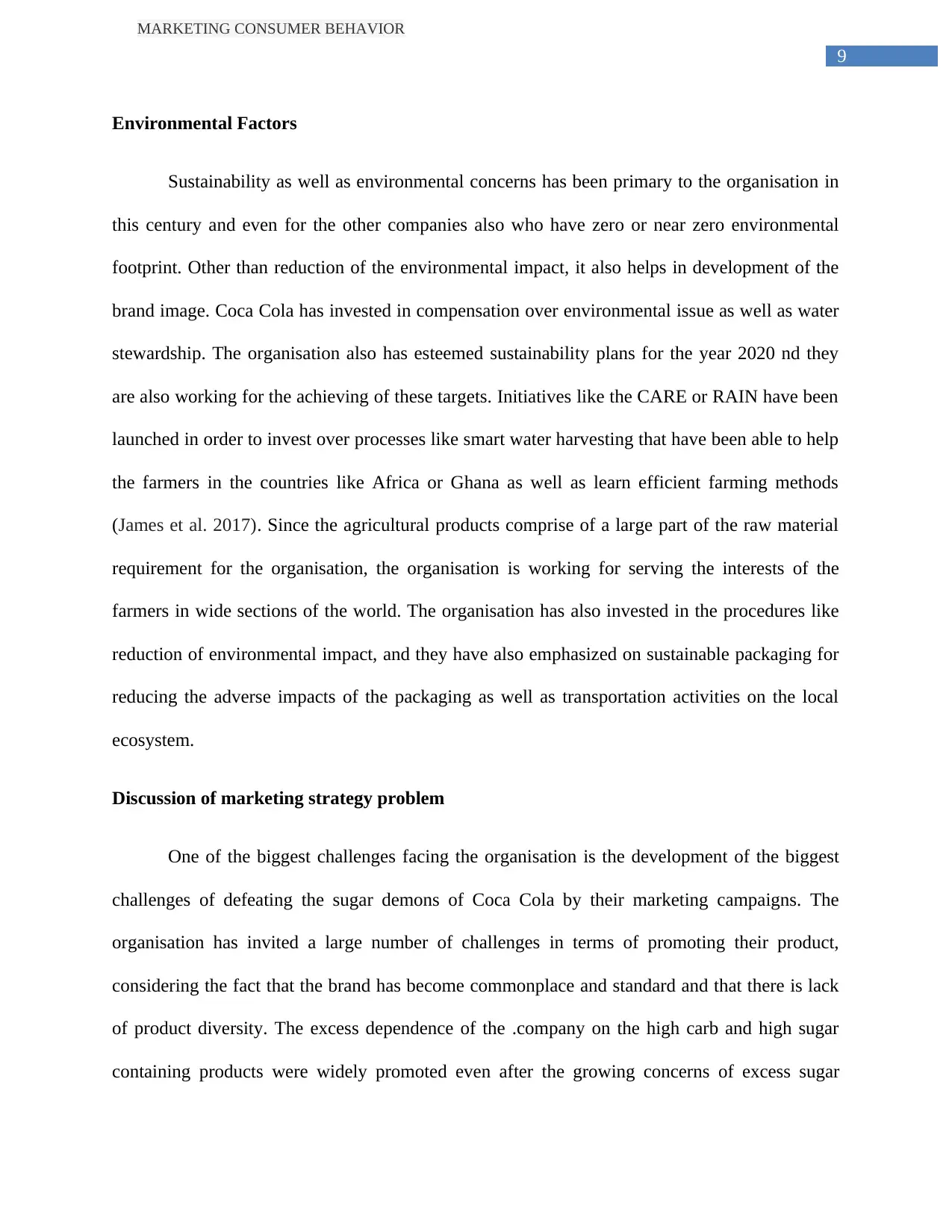
9
MARKETING CONSUMER BEHAVIOR
Environmental Factors
Sustainability as well as environmental concerns has been primary to the organisation in
this century and even for the other companies also who have zero or near zero environmental
footprint. Other than reduction of the environmental impact, it also helps in development of the
brand image. Coca Cola has invested in compensation over environmental issue as well as water
stewardship. The organisation also has esteemed sustainability plans for the year 2020 nd they
are also working for the achieving of these targets. Initiatives like the CARE or RAIN have been
launched in order to invest over processes like smart water harvesting that have been able to help
the farmers in the countries like Africa or Ghana as well as learn efficient farming methods
(James et al. 2017). Since the agricultural products comprise of a large part of the raw material
requirement for the organisation, the organisation is working for serving the interests of the
farmers in wide sections of the world. The organisation has also invested in the procedures like
reduction of environmental impact, and they have also emphasized on sustainable packaging for
reducing the adverse impacts of the packaging as well as transportation activities on the local
ecosystem.
Discussion of marketing strategy problem
One of the biggest challenges facing the organisation is the development of the biggest
challenges of defeating the sugar demons of Coca Cola by their marketing campaigns. The
organisation has invited a large number of challenges in terms of promoting their product,
considering the fact that the brand has become commonplace and standard and that there is lack
of product diversity. The excess dependence of the .company on the high carb and high sugar
containing products were widely promoted even after the growing concerns of excess sugar
MARKETING CONSUMER BEHAVIOR
Environmental Factors
Sustainability as well as environmental concerns has been primary to the organisation in
this century and even for the other companies also who have zero or near zero environmental
footprint. Other than reduction of the environmental impact, it also helps in development of the
brand image. Coca Cola has invested in compensation over environmental issue as well as water
stewardship. The organisation also has esteemed sustainability plans for the year 2020 nd they
are also working for the achieving of these targets. Initiatives like the CARE or RAIN have been
launched in order to invest over processes like smart water harvesting that have been able to help
the farmers in the countries like Africa or Ghana as well as learn efficient farming methods
(James et al. 2017). Since the agricultural products comprise of a large part of the raw material
requirement for the organisation, the organisation is working for serving the interests of the
farmers in wide sections of the world. The organisation has also invested in the procedures like
reduction of environmental impact, and they have also emphasized on sustainable packaging for
reducing the adverse impacts of the packaging as well as transportation activities on the local
ecosystem.
Discussion of marketing strategy problem
One of the biggest challenges facing the organisation is the development of the biggest
challenges of defeating the sugar demons of Coca Cola by their marketing campaigns. The
organisation has invited a large number of challenges in terms of promoting their product,
considering the fact that the brand has become commonplace and standard and that there is lack
of product diversity. The excess dependence of the .company on the high carb and high sugar
containing products were widely promoted even after the growing concerns of excess sugar
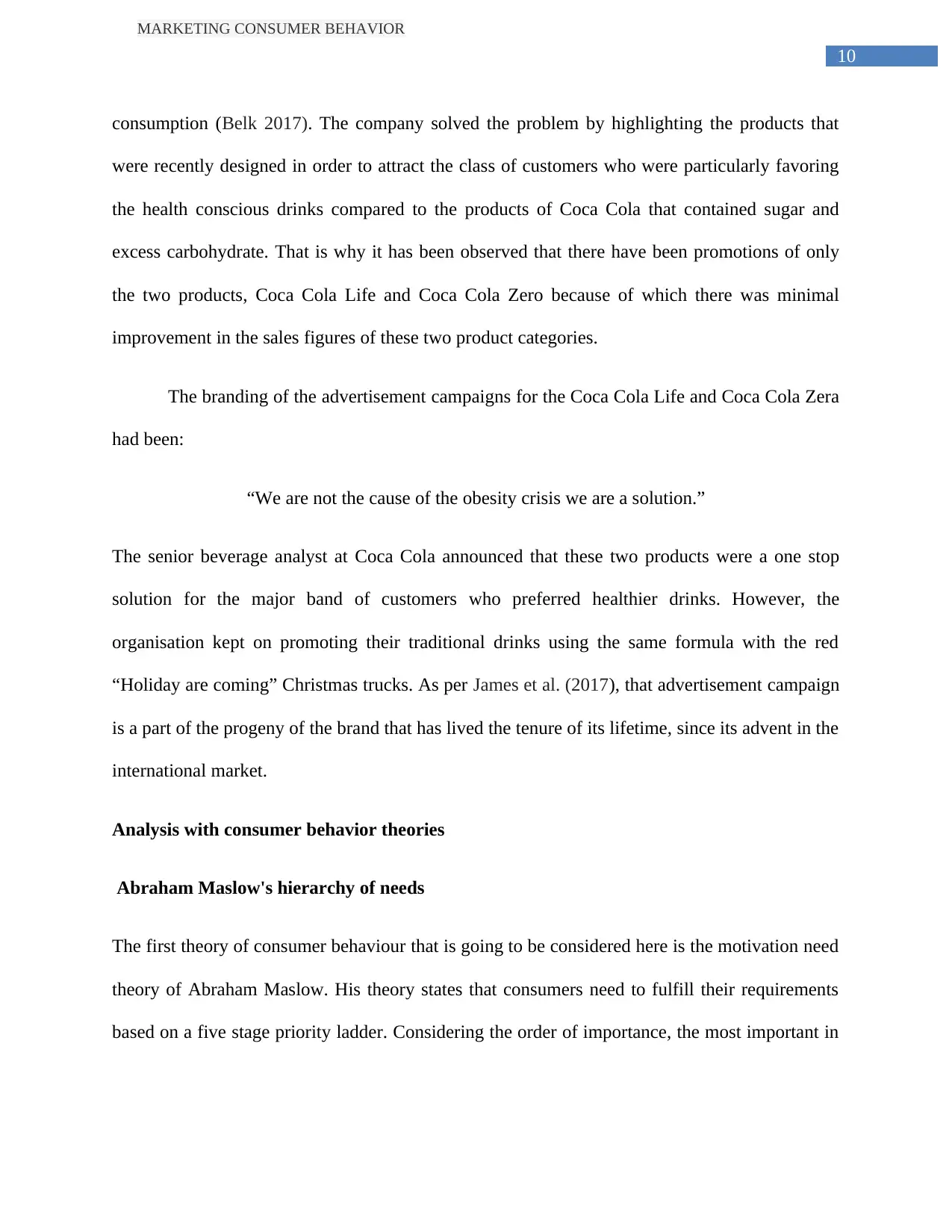
10
MARKETING CONSUMER BEHAVIOR
consumption (Belk 2017). The company solved the problem by highlighting the products that
were recently designed in order to attract the class of customers who were particularly favoring
the health conscious drinks compared to the products of Coca Cola that contained sugar and
excess carbohydrate. That is why it has been observed that there have been promotions of only
the two products, Coca Cola Life and Coca Cola Zero because of which there was minimal
improvement in the sales figures of these two product categories.
The branding of the advertisement campaigns for the Coca Cola Life and Coca Cola Zera
had been:
“We are not the cause of the obesity crisis we are a solution.”
The senior beverage analyst at Coca Cola announced that these two products were a one stop
solution for the major band of customers who preferred healthier drinks. However, the
organisation kept on promoting their traditional drinks using the same formula with the red
“Holiday are coming” Christmas trucks. As per James et al. (2017), that advertisement campaign
is a part of the progeny of the brand that has lived the tenure of its lifetime, since its advent in the
international market.
Analysis with consumer behavior theories
Abraham Maslow's hierarchy of needs
The first theory of consumer behaviour that is going to be considered here is the motivation need
theory of Abraham Maslow. His theory states that consumers need to fulfill their requirements
based on a five stage priority ladder. Considering the order of importance, the most important in
MARKETING CONSUMER BEHAVIOR
consumption (Belk 2017). The company solved the problem by highlighting the products that
were recently designed in order to attract the class of customers who were particularly favoring
the health conscious drinks compared to the products of Coca Cola that contained sugar and
excess carbohydrate. That is why it has been observed that there have been promotions of only
the two products, Coca Cola Life and Coca Cola Zero because of which there was minimal
improvement in the sales figures of these two product categories.
The branding of the advertisement campaigns for the Coca Cola Life and Coca Cola Zera
had been:
“We are not the cause of the obesity crisis we are a solution.”
The senior beverage analyst at Coca Cola announced that these two products were a one stop
solution for the major band of customers who preferred healthier drinks. However, the
organisation kept on promoting their traditional drinks using the same formula with the red
“Holiday are coming” Christmas trucks. As per James et al. (2017), that advertisement campaign
is a part of the progeny of the brand that has lived the tenure of its lifetime, since its advent in the
international market.
Analysis with consumer behavior theories
Abraham Maslow's hierarchy of needs
The first theory of consumer behaviour that is going to be considered here is the motivation need
theory of Abraham Maslow. His theory states that consumers need to fulfill their requirements
based on a five stage priority ladder. Considering the order of importance, the most important in
Secure Best Marks with AI Grader
Need help grading? Try our AI Grader for instant feedback on your assignments.

11
MARKETING CONSUMER BEHAVIOR
need is the psychological or survivor lead, after which come the needs like safety, love, Esteem
as well as self actualization.
In consideration to the first requirement that is the psychological or survival need of customers, it
can be concluded that the basic Apple of the advertising campaign is the focal point of popularity
of the product among the customers. However this value proposition works best for the countries
which have more than six months of Summer. This is why the principle behind the advertising
campaigns of Coca Cola in the Asian African and some countries of Pan Pacific region includes
the message that the beverage products of Coca Cola gives relief to the people in the hot summer
months. the television advertisements of Coca-Cola in these regions is built on the principle that
the leading personality in the advertisement will feel refreshed the moment he or she can use
Coca-Cola or any of their subsidiary products. The perception is that be energetic is also
necessary during the summer months because there is no scope of wrestling or being lethargic in
our busy life. That is why, in some advertisements of Coca-Cola we find group of young boys
running behind the big red Christmas frock of Coca-Cola in order to satisfy their refreshment
needs. The truck driver, watching the eagerness among the group, stops the truck to allow the
children to take a bottle of Coca-Cola (Chalikias and Skordoulis 2017).
Considering safety requirements, it can be commented that Coca-Cola has not always been
successful in fulfilling the safety needs of the community. On several locations, allegations
regarding products of Coca Cola which includes the claims that they are carcinogenic, they
contain more than adequate level of sugar which can be accountable for diabetes and so on.
Coca-Cola tried to develop innovative advertisements featuring local celebrities, pledging people
and inviting them to come at any of the production units of Coca-Cola and witness the hygienic
process with which Coca-Cola is manufactured.
MARKETING CONSUMER BEHAVIOR
need is the psychological or survivor lead, after which come the needs like safety, love, Esteem
as well as self actualization.
In consideration to the first requirement that is the psychological or survival need of customers, it
can be concluded that the basic Apple of the advertising campaign is the focal point of popularity
of the product among the customers. However this value proposition works best for the countries
which have more than six months of Summer. This is why the principle behind the advertising
campaigns of Coca Cola in the Asian African and some countries of Pan Pacific region includes
the message that the beverage products of Coca Cola gives relief to the people in the hot summer
months. the television advertisements of Coca-Cola in these regions is built on the principle that
the leading personality in the advertisement will feel refreshed the moment he or she can use
Coca-Cola or any of their subsidiary products. The perception is that be energetic is also
necessary during the summer months because there is no scope of wrestling or being lethargic in
our busy life. That is why, in some advertisements of Coca-Cola we find group of young boys
running behind the big red Christmas frock of Coca-Cola in order to satisfy their refreshment
needs. The truck driver, watching the eagerness among the group, stops the truck to allow the
children to take a bottle of Coca-Cola (Chalikias and Skordoulis 2017).
Considering safety requirements, it can be commented that Coca-Cola has not always been
successful in fulfilling the safety needs of the community. On several locations, allegations
regarding products of Coca Cola which includes the claims that they are carcinogenic, they
contain more than adequate level of sugar which can be accountable for diabetes and so on.
Coca-Cola tried to develop innovative advertisements featuring local celebrities, pledging people
and inviting them to come at any of the production units of Coca-Cola and witness the hygienic
process with which Coca-Cola is manufactured.
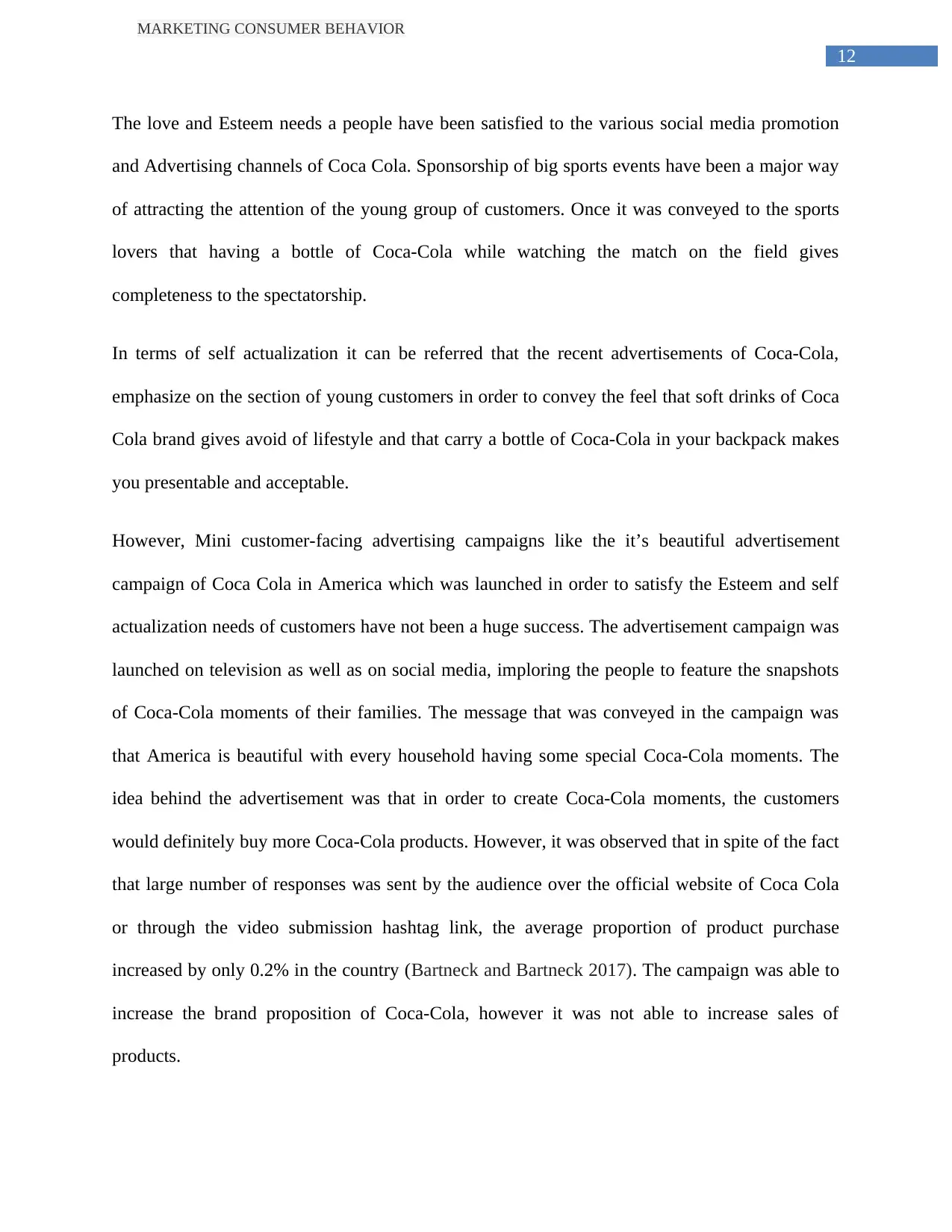
12
MARKETING CONSUMER BEHAVIOR
The love and Esteem needs a people have been satisfied to the various social media promotion
and Advertising channels of Coca Cola. Sponsorship of big sports events have been a major way
of attracting the attention of the young group of customers. Once it was conveyed to the sports
lovers that having a bottle of Coca-Cola while watching the match on the field gives
completeness to the spectatorship.
In terms of self actualization it can be referred that the recent advertisements of Coca-Cola,
emphasize on the section of young customers in order to convey the feel that soft drinks of Coca
Cola brand gives avoid of lifestyle and that carry a bottle of Coca-Cola in your backpack makes
you presentable and acceptable.
However, Mini customer-facing advertising campaigns like the it’s beautiful advertisement
campaign of Coca Cola in America which was launched in order to satisfy the Esteem and self
actualization needs of customers have not been a huge success. The advertisement campaign was
launched on television as well as on social media, imploring the people to feature the snapshots
of Coca-Cola moments of their families. The message that was conveyed in the campaign was
that America is beautiful with every household having some special Coca-Cola moments. The
idea behind the advertisement was that in order to create Coca-Cola moments, the customers
would definitely buy more Coca-Cola products. However, it was observed that in spite of the fact
that large number of responses was sent by the audience over the official website of Coca Cola
or through the video submission hashtag link, the average proportion of product purchase
increased by only 0.2% in the country (Bartneck and Bartneck 2017). The campaign was able to
increase the brand proposition of Coca-Cola, however it was not able to increase sales of
products.
MARKETING CONSUMER BEHAVIOR
The love and Esteem needs a people have been satisfied to the various social media promotion
and Advertising channels of Coca Cola. Sponsorship of big sports events have been a major way
of attracting the attention of the young group of customers. Once it was conveyed to the sports
lovers that having a bottle of Coca-Cola while watching the match on the field gives
completeness to the spectatorship.
In terms of self actualization it can be referred that the recent advertisements of Coca-Cola,
emphasize on the section of young customers in order to convey the feel that soft drinks of Coca
Cola brand gives avoid of lifestyle and that carry a bottle of Coca-Cola in your backpack makes
you presentable and acceptable.
However, Mini customer-facing advertising campaigns like the it’s beautiful advertisement
campaign of Coca Cola in America which was launched in order to satisfy the Esteem and self
actualization needs of customers have not been a huge success. The advertisement campaign was
launched on television as well as on social media, imploring the people to feature the snapshots
of Coca-Cola moments of their families. The message that was conveyed in the campaign was
that America is beautiful with every household having some special Coca-Cola moments. The
idea behind the advertisement was that in order to create Coca-Cola moments, the customers
would definitely buy more Coca-Cola products. However, it was observed that in spite of the fact
that large number of responses was sent by the audience over the official website of Coca Cola
or through the video submission hashtag link, the average proportion of product purchase
increased by only 0.2% in the country (Bartneck and Bartneck 2017). The campaign was able to
increase the brand proposition of Coca-Cola, however it was not able to increase sales of
products.
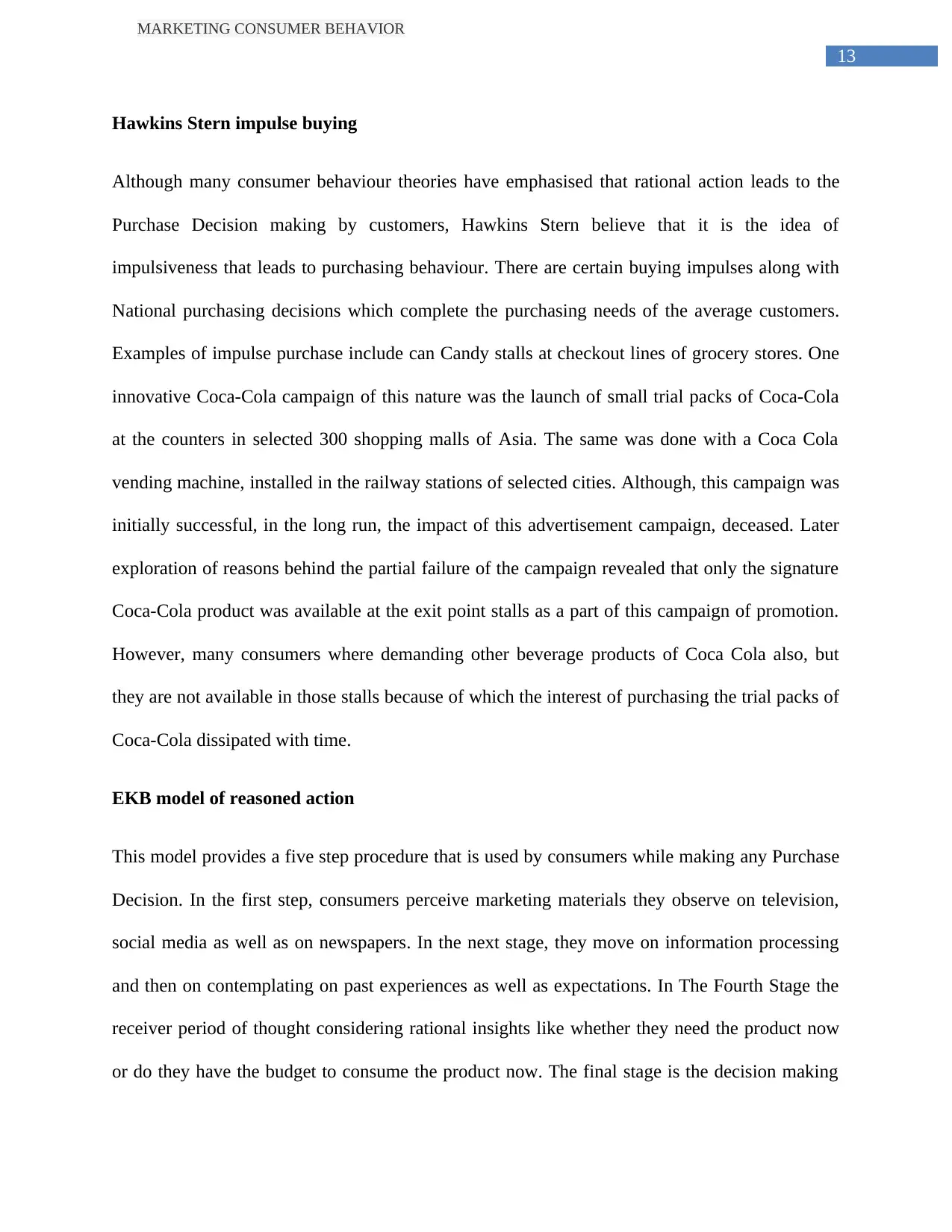
13
MARKETING CONSUMER BEHAVIOR
Hawkins Stern impulse buying
Although many consumer behaviour theories have emphasised that rational action leads to the
Purchase Decision making by customers, Hawkins Stern believe that it is the idea of
impulsiveness that leads to purchasing behaviour. There are certain buying impulses along with
National purchasing decisions which complete the purchasing needs of the average customers.
Examples of impulse purchase include can Candy stalls at checkout lines of grocery stores. One
innovative Coca-Cola campaign of this nature was the launch of small trial packs of Coca-Cola
at the counters in selected 300 shopping malls of Asia. The same was done with a Coca Cola
vending machine, installed in the railway stations of selected cities. Although, this campaign was
initially successful, in the long run, the impact of this advertisement campaign, deceased. Later
exploration of reasons behind the partial failure of the campaign revealed that only the signature
Coca-Cola product was available at the exit point stalls as a part of this campaign of promotion.
However, many consumers where demanding other beverage products of Coca Cola also, but
they are not available in those stalls because of which the interest of purchasing the trial packs of
Coca-Cola dissipated with time.
EKB model of reasoned action
This model provides a five step procedure that is used by consumers while making any Purchase
Decision. In the first step, consumers perceive marketing materials they observe on television,
social media as well as on newspapers. In the next stage, they move on information processing
and then on contemplating on past experiences as well as expectations. In The Fourth Stage the
receiver period of thought considering rational insights like whether they need the product now
or do they have the budget to consume the product now. The final stage is the decision making
MARKETING CONSUMER BEHAVIOR
Hawkins Stern impulse buying
Although many consumer behaviour theories have emphasised that rational action leads to the
Purchase Decision making by customers, Hawkins Stern believe that it is the idea of
impulsiveness that leads to purchasing behaviour. There are certain buying impulses along with
National purchasing decisions which complete the purchasing needs of the average customers.
Examples of impulse purchase include can Candy stalls at checkout lines of grocery stores. One
innovative Coca-Cola campaign of this nature was the launch of small trial packs of Coca-Cola
at the counters in selected 300 shopping malls of Asia. The same was done with a Coca Cola
vending machine, installed in the railway stations of selected cities. Although, this campaign was
initially successful, in the long run, the impact of this advertisement campaign, deceased. Later
exploration of reasons behind the partial failure of the campaign revealed that only the signature
Coca-Cola product was available at the exit point stalls as a part of this campaign of promotion.
However, many consumers where demanding other beverage products of Coca Cola also, but
they are not available in those stalls because of which the interest of purchasing the trial packs of
Coca-Cola dissipated with time.
EKB model of reasoned action
This model provides a five step procedure that is used by consumers while making any Purchase
Decision. In the first step, consumers perceive marketing materials they observe on television,
social media as well as on newspapers. In the next stage, they move on information processing
and then on contemplating on past experiences as well as expectations. In The Fourth Stage the
receiver period of thought considering rational insights like whether they need the product now
or do they have the budget to consume the product now. The final stage is the decision making
Paraphrase This Document
Need a fresh take? Get an instant paraphrase of this document with our AI Paraphraser
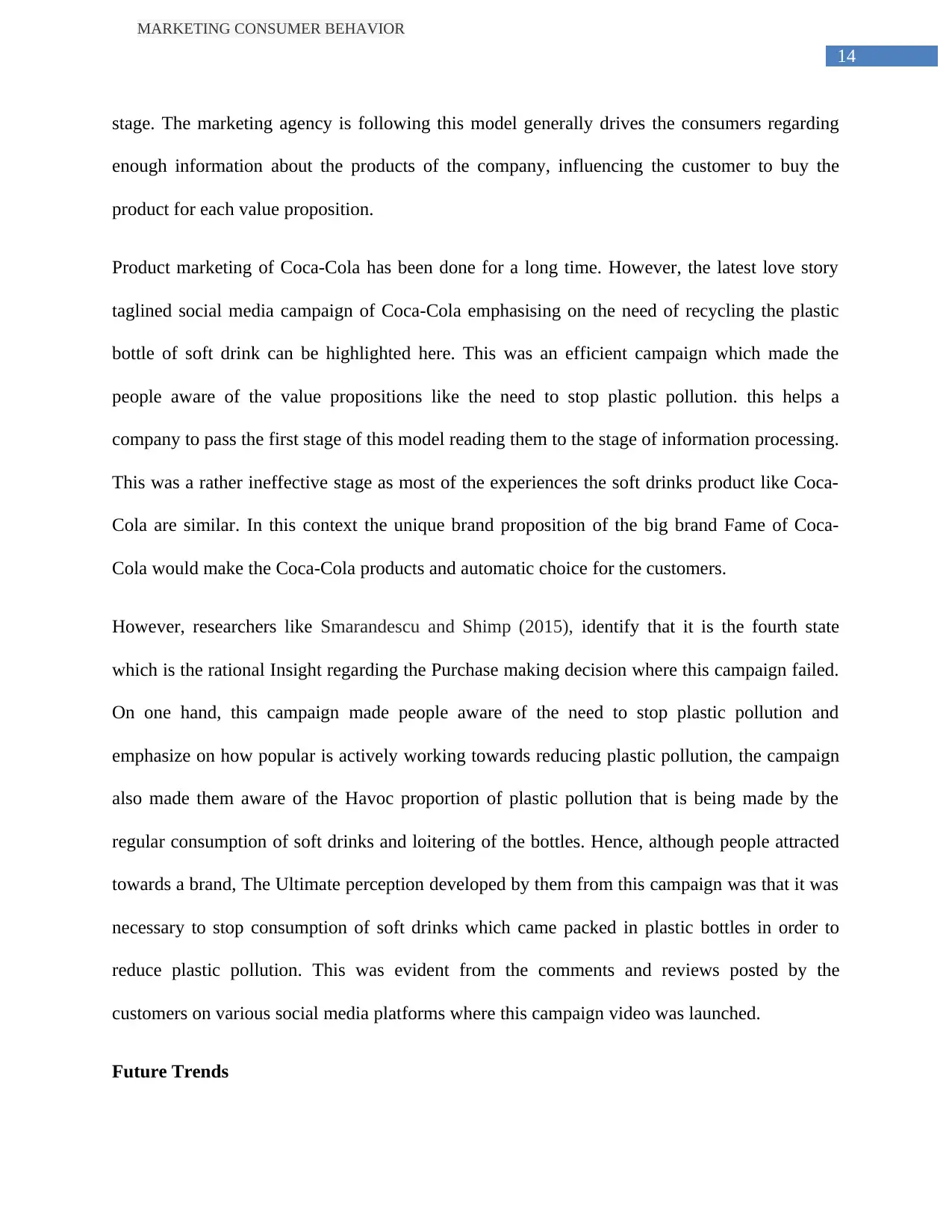
14
MARKETING CONSUMER BEHAVIOR
stage. The marketing agency is following this model generally drives the consumers regarding
enough information about the products of the company, influencing the customer to buy the
product for each value proposition.
Product marketing of Coca-Cola has been done for a long time. However, the latest love story
taglined social media campaign of Coca-Cola emphasising on the need of recycling the plastic
bottle of soft drink can be highlighted here. This was an efficient campaign which made the
people aware of the value propositions like the need to stop plastic pollution. this helps a
company to pass the first stage of this model reading them to the stage of information processing.
This was a rather ineffective stage as most of the experiences the soft drinks product like Coca-
Cola are similar. In this context the unique brand proposition of the big brand Fame of Coca-
Cola would make the Coca-Cola products and automatic choice for the customers.
However, researchers like Smarandescu and Shimp (2015), identify that it is the fourth state
which is the rational Insight regarding the Purchase making decision where this campaign failed.
On one hand, this campaign made people aware of the need to stop plastic pollution and
emphasize on how popular is actively working towards reducing plastic pollution, the campaign
also made them aware of the Havoc proportion of plastic pollution that is being made by the
regular consumption of soft drinks and loitering of the bottles. Hence, although people attracted
towards a brand, The Ultimate perception developed by them from this campaign was that it was
necessary to stop consumption of soft drinks which came packed in plastic bottles in order to
reduce plastic pollution. This was evident from the comments and reviews posted by the
customers on various social media platforms where this campaign video was launched.
Future Trends
MARKETING CONSUMER BEHAVIOR
stage. The marketing agency is following this model generally drives the consumers regarding
enough information about the products of the company, influencing the customer to buy the
product for each value proposition.
Product marketing of Coca-Cola has been done for a long time. However, the latest love story
taglined social media campaign of Coca-Cola emphasising on the need of recycling the plastic
bottle of soft drink can be highlighted here. This was an efficient campaign which made the
people aware of the value propositions like the need to stop plastic pollution. this helps a
company to pass the first stage of this model reading them to the stage of information processing.
This was a rather ineffective stage as most of the experiences the soft drinks product like Coca-
Cola are similar. In this context the unique brand proposition of the big brand Fame of Coca-
Cola would make the Coca-Cola products and automatic choice for the customers.
However, researchers like Smarandescu and Shimp (2015), identify that it is the fourth state
which is the rational Insight regarding the Purchase making decision where this campaign failed.
On one hand, this campaign made people aware of the need to stop plastic pollution and
emphasize on how popular is actively working towards reducing plastic pollution, the campaign
also made them aware of the Havoc proportion of plastic pollution that is being made by the
regular consumption of soft drinks and loitering of the bottles. Hence, although people attracted
towards a brand, The Ultimate perception developed by them from this campaign was that it was
necessary to stop consumption of soft drinks which came packed in plastic bottles in order to
reduce plastic pollution. This was evident from the comments and reviews posted by the
customers on various social media platforms where this campaign video was launched.
Future Trends
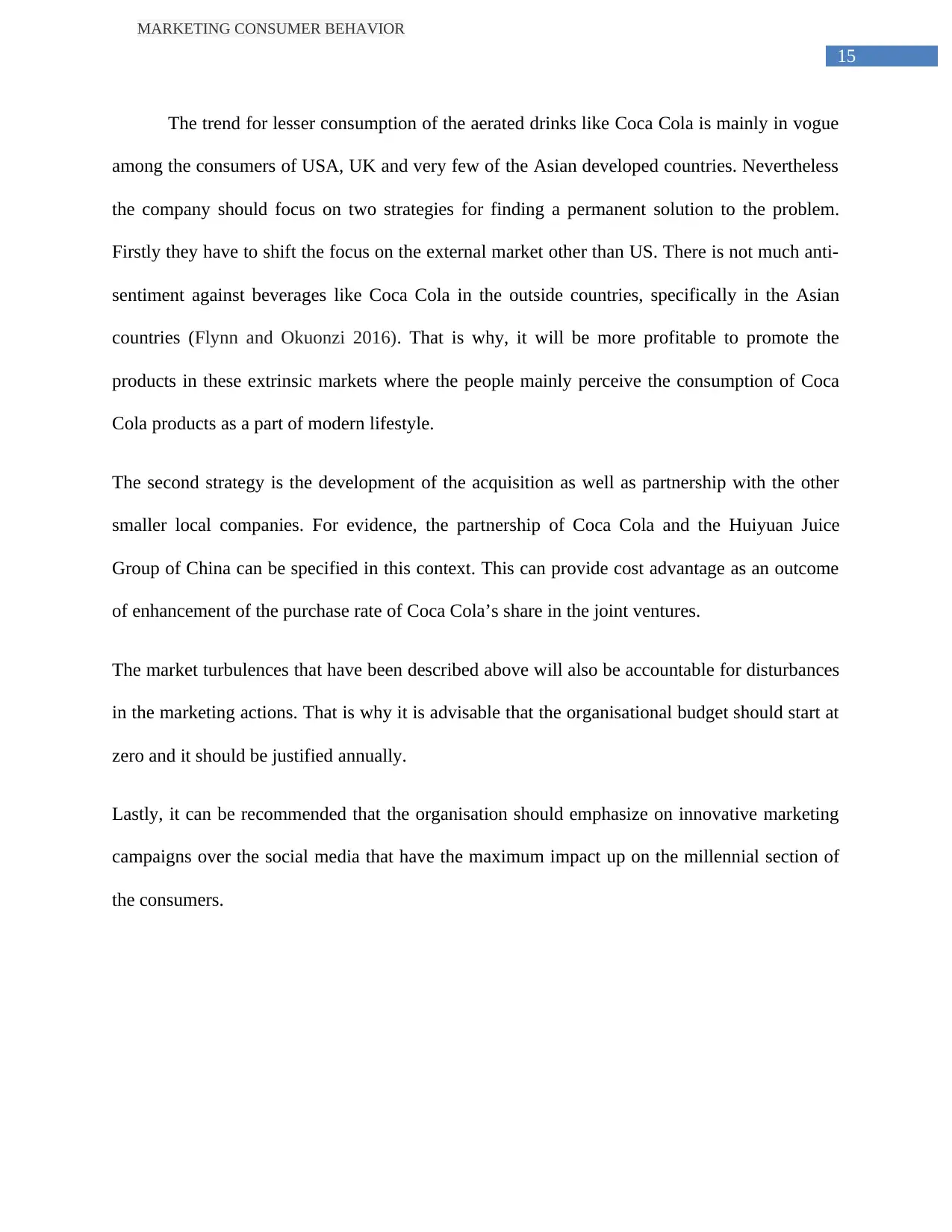
15
MARKETING CONSUMER BEHAVIOR
The trend for lesser consumption of the aerated drinks like Coca Cola is mainly in vogue
among the consumers of USA, UK and very few of the Asian developed countries. Nevertheless
the company should focus on two strategies for finding a permanent solution to the problem.
Firstly they have to shift the focus on the external market other than US. There is not much anti-
sentiment against beverages like Coca Cola in the outside countries, specifically in the Asian
countries (Flynn and Okuonzi 2016). That is why, it will be more profitable to promote the
products in these extrinsic markets where the people mainly perceive the consumption of Coca
Cola products as a part of modern lifestyle.
The second strategy is the development of the acquisition as well as partnership with the other
smaller local companies. For evidence, the partnership of Coca Cola and the Huiyuan Juice
Group of China can be specified in this context. This can provide cost advantage as an outcome
of enhancement of the purchase rate of Coca Cola’s share in the joint ventures.
The market turbulences that have been described above will also be accountable for disturbances
in the marketing actions. That is why it is advisable that the organisational budget should start at
zero and it should be justified annually.
Lastly, it can be recommended that the organisation should emphasize on innovative marketing
campaigns over the social media that have the maximum impact up on the millennial section of
the consumers.
MARKETING CONSUMER BEHAVIOR
The trend for lesser consumption of the aerated drinks like Coca Cola is mainly in vogue
among the consumers of USA, UK and very few of the Asian developed countries. Nevertheless
the company should focus on two strategies for finding a permanent solution to the problem.
Firstly they have to shift the focus on the external market other than US. There is not much anti-
sentiment against beverages like Coca Cola in the outside countries, specifically in the Asian
countries (Flynn and Okuonzi 2016). That is why, it will be more profitable to promote the
products in these extrinsic markets where the people mainly perceive the consumption of Coca
Cola products as a part of modern lifestyle.
The second strategy is the development of the acquisition as well as partnership with the other
smaller local companies. For evidence, the partnership of Coca Cola and the Huiyuan Juice
Group of China can be specified in this context. This can provide cost advantage as an outcome
of enhancement of the purchase rate of Coca Cola’s share in the joint ventures.
The market turbulences that have been described above will also be accountable for disturbances
in the marketing actions. That is why it is advisable that the organisational budget should start at
zero and it should be justified annually.
Lastly, it can be recommended that the organisation should emphasize on innovative marketing
campaigns over the social media that have the maximum impact up on the millennial section of
the consumers.
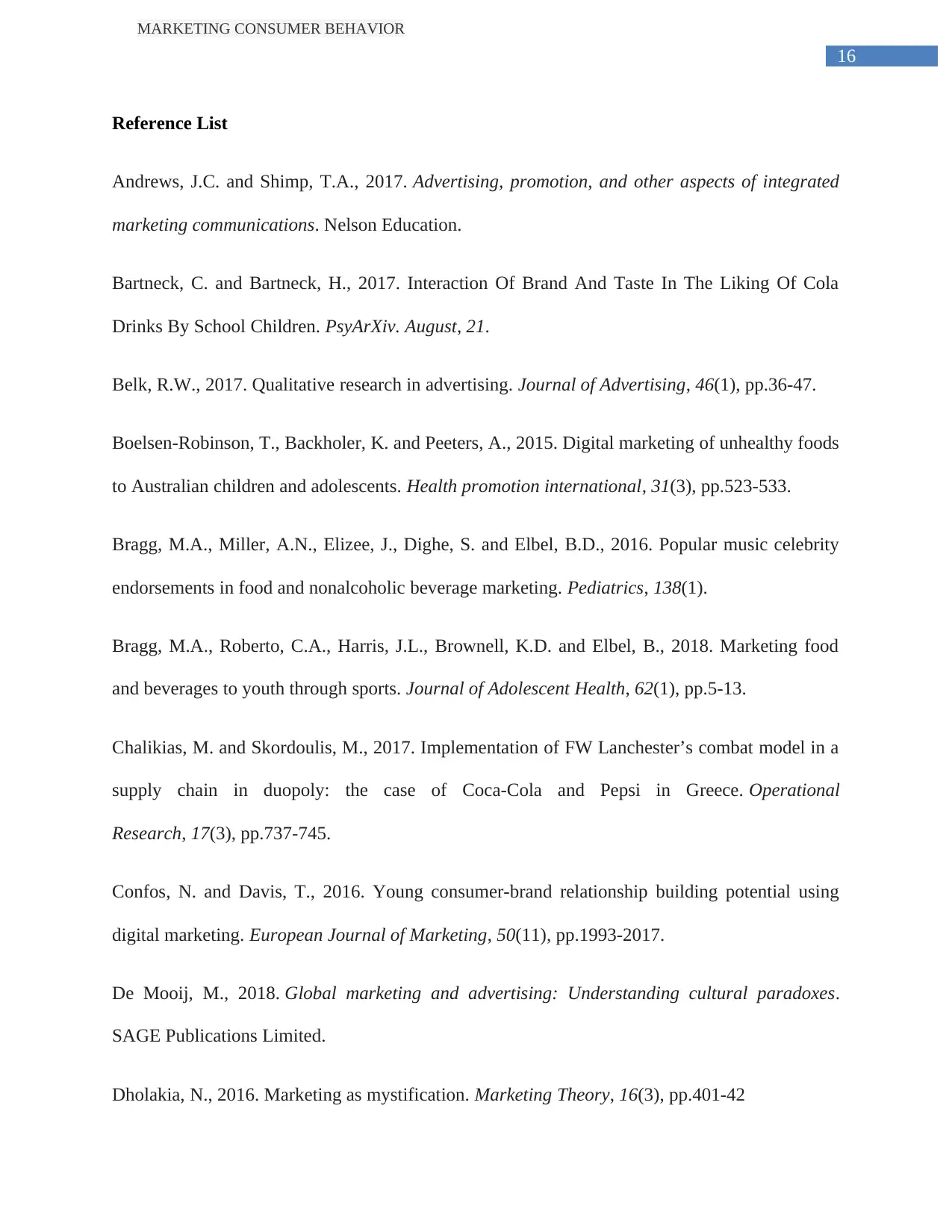
16
MARKETING CONSUMER BEHAVIOR
Reference List
Andrews, J.C. and Shimp, T.A., 2017. Advertising, promotion, and other aspects of integrated
marketing communications. Nelson Education.
Bartneck, C. and Bartneck, H., 2017. Interaction Of Brand And Taste In The Liking Of Cola
Drinks By School Children. PsyArXiv. August, 21.
Belk, R.W., 2017. Qualitative research in advertising. Journal of Advertising, 46(1), pp.36-47.
Boelsen-Robinson, T., Backholer, K. and Peeters, A., 2015. Digital marketing of unhealthy foods
to Australian children and adolescents. Health promotion international, 31(3), pp.523-533.
Bragg, M.A., Miller, A.N., Elizee, J., Dighe, S. and Elbel, B.D., 2016. Popular music celebrity
endorsements in food and nonalcoholic beverage marketing. Pediatrics, 138(1).
Bragg, M.A., Roberto, C.A., Harris, J.L., Brownell, K.D. and Elbel, B., 2018. Marketing food
and beverages to youth through sports. Journal of Adolescent Health, 62(1), pp.5-13.
Chalikias, M. and Skordoulis, M., 2017. Implementation of FW Lanchester’s combat model in a
supply chain in duopoly: the case of Coca-Cola and Pepsi in Greece. Operational
Research, 17(3), pp.737-745.
Confos, N. and Davis, T., 2016. Young consumer-brand relationship building potential using
digital marketing. European Journal of Marketing, 50(11), pp.1993-2017.
De Mooij, M., 2018. Global marketing and advertising: Understanding cultural paradoxes.
SAGE Publications Limited.
Dholakia, N., 2016. Marketing as mystification. Marketing Theory, 16(3), pp.401-42
MARKETING CONSUMER BEHAVIOR
Reference List
Andrews, J.C. and Shimp, T.A., 2017. Advertising, promotion, and other aspects of integrated
marketing communications. Nelson Education.
Bartneck, C. and Bartneck, H., 2017. Interaction Of Brand And Taste In The Liking Of Cola
Drinks By School Children. PsyArXiv. August, 21.
Belk, R.W., 2017. Qualitative research in advertising. Journal of Advertising, 46(1), pp.36-47.
Boelsen-Robinson, T., Backholer, K. and Peeters, A., 2015. Digital marketing of unhealthy foods
to Australian children and adolescents. Health promotion international, 31(3), pp.523-533.
Bragg, M.A., Miller, A.N., Elizee, J., Dighe, S. and Elbel, B.D., 2016. Popular music celebrity
endorsements in food and nonalcoholic beverage marketing. Pediatrics, 138(1).
Bragg, M.A., Roberto, C.A., Harris, J.L., Brownell, K.D. and Elbel, B., 2018. Marketing food
and beverages to youth through sports. Journal of Adolescent Health, 62(1), pp.5-13.
Chalikias, M. and Skordoulis, M., 2017. Implementation of FW Lanchester’s combat model in a
supply chain in duopoly: the case of Coca-Cola and Pepsi in Greece. Operational
Research, 17(3), pp.737-745.
Confos, N. and Davis, T., 2016. Young consumer-brand relationship building potential using
digital marketing. European Journal of Marketing, 50(11), pp.1993-2017.
De Mooij, M., 2018. Global marketing and advertising: Understanding cultural paradoxes.
SAGE Publications Limited.
Dholakia, N., 2016. Marketing as mystification. Marketing Theory, 16(3), pp.401-42
Secure Best Marks with AI Grader
Need help grading? Try our AI Grader for instant feedback on your assignments.
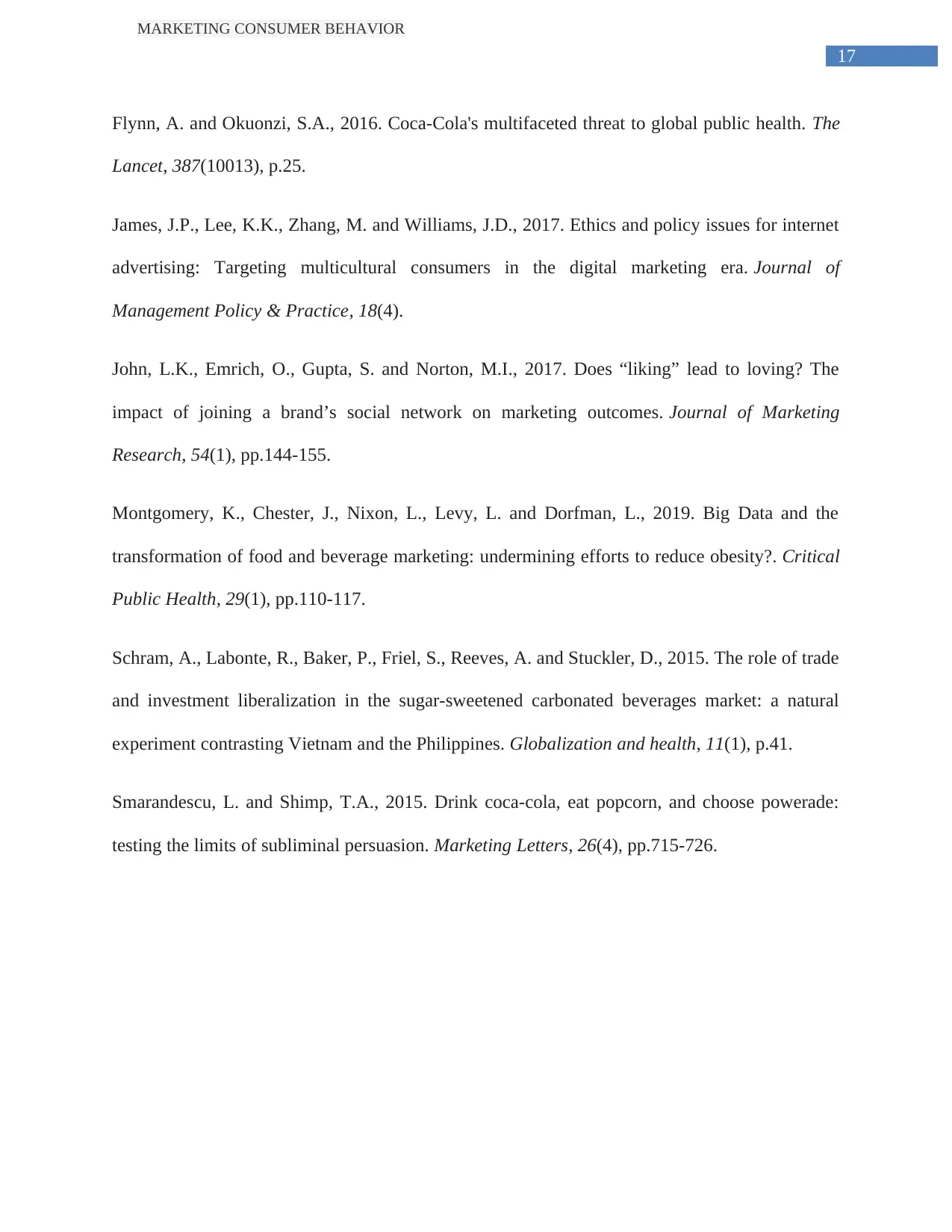
17
MARKETING CONSUMER BEHAVIOR
Flynn, A. and Okuonzi, S.A., 2016. Coca-Cola's multifaceted threat to global public health. The
Lancet, 387(10013), p.25.
James, J.P., Lee, K.K., Zhang, M. and Williams, J.D., 2017. Ethics and policy issues for internet
advertising: Targeting multicultural consumers in the digital marketing era. Journal of
Management Policy & Practice, 18(4).
John, L.K., Emrich, O., Gupta, S. and Norton, M.I., 2017. Does “liking” lead to loving? The
impact of joining a brand’s social network on marketing outcomes. Journal of Marketing
Research, 54(1), pp.144-155.
Montgomery, K., Chester, J., Nixon, L., Levy, L. and Dorfman, L., 2019. Big Data and the
transformation of food and beverage marketing: undermining efforts to reduce obesity?. Critical
Public Health, 29(1), pp.110-117.
Schram, A., Labonte, R., Baker, P., Friel, S., Reeves, A. and Stuckler, D., 2015. The role of trade
and investment liberalization in the sugar-sweetened carbonated beverages market: a natural
experiment contrasting Vietnam and the Philippines. Globalization and health, 11(1), p.41.
Smarandescu, L. and Shimp, T.A., 2015. Drink coca-cola, eat popcorn, and choose powerade:
testing the limits of subliminal persuasion. Marketing Letters, 26(4), pp.715-726.
MARKETING CONSUMER BEHAVIOR
Flynn, A. and Okuonzi, S.A., 2016. Coca-Cola's multifaceted threat to global public health. The
Lancet, 387(10013), p.25.
James, J.P., Lee, K.K., Zhang, M. and Williams, J.D., 2017. Ethics and policy issues for internet
advertising: Targeting multicultural consumers in the digital marketing era. Journal of
Management Policy & Practice, 18(4).
John, L.K., Emrich, O., Gupta, S. and Norton, M.I., 2017. Does “liking” lead to loving? The
impact of joining a brand’s social network on marketing outcomes. Journal of Marketing
Research, 54(1), pp.144-155.
Montgomery, K., Chester, J., Nixon, L., Levy, L. and Dorfman, L., 2019. Big Data and the
transformation of food and beverage marketing: undermining efforts to reduce obesity?. Critical
Public Health, 29(1), pp.110-117.
Schram, A., Labonte, R., Baker, P., Friel, S., Reeves, A. and Stuckler, D., 2015. The role of trade
and investment liberalization in the sugar-sweetened carbonated beverages market: a natural
experiment contrasting Vietnam and the Philippines. Globalization and health, 11(1), p.41.
Smarandescu, L. and Shimp, T.A., 2015. Drink coca-cola, eat popcorn, and choose powerade:
testing the limits of subliminal persuasion. Marketing Letters, 26(4), pp.715-726.
1 out of 17
Related Documents
Your All-in-One AI-Powered Toolkit for Academic Success.
+13062052269
info@desklib.com
Available 24*7 on WhatsApp / Email
![[object Object]](/_next/static/media/star-bottom.7253800d.svg)
Unlock your academic potential
© 2024 | Zucol Services PVT LTD | All rights reserved.





